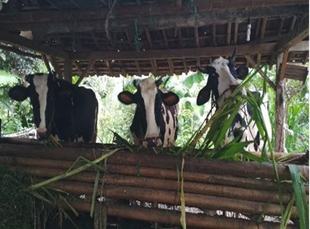Reproduction record of captive Sumatera elephant (Elephas maximus sumatranus) at Way Kambas National Park, Indonesia

Downloads
This research aims to determine reproductive data on Sumatran elephants (Elephas maximus sumatranus) in the ETC and ERU of Way Kambas National Park, Indonesia during 1988-2021. Data recorded from the elephant population at both locations (ETC and ERU) includes the number, gender of elephants, elephant calves, ages and birth dates. Calving intervals and service periods were calculated from calving records of cows with a minimum parity of two. Data collection produced data on 47 elephant calves from 13 female elephants with at least twice the parity and 12 primiparous cows. Elephant reproductive records at ETC and ERU were: age (37.44 ± 9.03 vs. 29.75 ± 3.30 years), parity (2.78 ± 1.09 vs. 2.50 ± 0.58), and age at first birth (18, 11 ± 3.92 vs. 17.75 ± 0.50 years). While the calving interval was 1857.56 ± 870.81 vs. 1833.00 ± 305.18 days, and service period respectively 1229.44 ± 846.18 vs. 1210.50 ± 283.59 days, respectively. It can be concluded that the calving interval and service period for captive elephants at ETC and ERU were not much different and were within the normal range. Young cows showed better reproductive efficiency than older cows. Monitoring calves is very important. Further assistance is needed to improve elephant mobile veterinary services, increase diagnostic laboratory capacity, and educate camp managers, veterinary assistants, and mahouts about elephant diseases, their monitoring and treatment. In addition, the use of reproductive technology such as monitoring ovulation using ultrasound and carrying out artificial insemination was expected to increase reproductive efficiency.
Brown JL, Kersey DC, Walker SL. 2010. Assessment of luteinizing hormone and prolactin immunoactivity in Asian and African elephant urine using assays validated for serum. Gen Comp Endocrinol. 169: 138-43.
Brown JL, Walker SL, Moeller T. 2004. Comparative endocrinology of cycling and non-cycling Asian (Elephas maximus) and African (Loxodonta africana) elephants. Gen Comp Endocrinol. 136: 360-70.
Brown JL. 2014. Comparative reproductive biology of elephants. Adv Exp Med Biol. 753: 135-69.
Brown JL. 2018. Elephants. Smithsonian Conservation Biology Institute. Front Royal, VA. United States. 659-661.
Dhairykar M, Singh KP. 2020. Management of nutrition in captive Asian elephants. Int J Vet Sci Anim Husb. 5: 160-3.
Dierenfeld ES, Han YAM, Mar KU, Aung A, Soe AT, Lummaa V, Lahdenperä M. 2020. Milk composition of Asian elephants (Elephas maximus) in a natural environment in Myanmar during late lactation. Animals 10:725.
Directorate General of Ecosystem Natural Resources Conservation (DGENRC). 2020. Rencana tindakan mendesak penyelamatan populasi gajah Sumatera (Elephas maximus sumatranus) 2020-2023. Direktorat KKH-KSDAE Kementerian Lingkungan Hidup dan Kehutanan Republik Indonesia. Jakarta. 5.
Google maps. 2023. Way Kambas National Park. 23 August 2022.
Hapsari A. 2003. Potensi dan profil reproduksi gajah Sumatera (Elephas maximus sumatranus) di Pusat Latihan Gajah Taman Nasional Way Kambas, Lampung. Skripsi. Fakultas Kedokteran Hewan. Institut Pertanian Bogor.
Hildebrandt T, Drews B, Gaeth AP, Goeritz F, Hermes R, Schmitt D, Gray C, Rich P, Streich WJ, Short RV, Renfree MB. 2007. Foetal age determination and development in elephants. Proc Biol Sci. 274: 323-31.
Hildebrandt TB. 2006. Aspects of the reproductive biology and breeding management of Asian and African elephants. Int Zoo Yearb 40: 23-7.
Islami FN, Candra D, Esti DA, Priyambodo P. 2016. Study on health care management system of captive sumatran elephant (Elephas maximus sumateranus) in Prof. Dr. Ir. M. Rubini Atmawidjaja Elephant Hospital, Way Kambas National Park. International Wildlife Symposium 2016. Bandar Lampung, Indonesia.
Kaewmanee S, Watanabe G, Kishimoto M, Jin WZ, Yamamoto Y, Yamamoto T, Nagaoka K, Narushima E, Komiya T, Taya K. 2011. Secretion of inhibin during the estrous cycle in the female Asian elephant (Elephas maximus). J Vet Med Sci. 73: 77-82.
Latitude. 2023. Latitude and longitude of Way Kambas National Park in Indonesia.
Medawala M, Gunawardana SM, Ranawana K. 2023. Captive breeding of Asian elephants at the Pinnawala Elephant Orphanage, Sri Lanka. Gajah 56: 17-22.
Meteorology Climatology and Geophysics Council (MCGC). 2022. Climate and weather of Way Kambas National Park. 3 Februari 2022.
Muslimiah M, Priyanto R, Jakaria J. 2023. Reproductive performance of bali cows through artificial insemination program in Polewali Mandar, West Sulawesi. Hasanuddin J Anim Sci. 5: 18-27.
Nancy S. 2019. Aktivitas nokturnal gajah Sumatera (Elephas maximus sumatranus) di kandang sosialisasi kawasan hutan dengan tujuan khusus (KHDTK) Aek Nauli, Simalungun, Sumatera Utara. Skripsi. Fakultas Matematika dan Ilmu Pengetahuan Alam. Universitas Sumatera Utara. Medan.
Oelrichs CM-C, Lloyd DJ, Christidis L. 2016. Strategies for mitigating forest arson and elephant conflict in Way Kambas National Park, Sumatra, Indonesia. Trop Conserv Sci. 9: 565-83.
Ong L, Harn TW, Lisa C D, McConkey KR, Mat Amin MKA, Ahimsa C-A, Terborgh JW. 2023. Asian elephants as ecological filters in Sundaic forests. Front For Glob Change 6: 1-12.
Pla-Ard M, Sukmasuang R, Uthairasmee S. 2022. Some population characteristics and viability of captive Asian elephant (Elephas maximus) in Thailand. Biodiversitas 23: 1072-81.
Pushpakumara PG, Rajapakse RC, Perera BM, Brown JL. 2016. Reproductive performance of the largest captive Asian elephant (Elephas maximus) population in Sri Lanka. Anim Reprod Sci. 174: 93-9.
Resphaty DA, Harianto SP, Dewi BS. 2015. Salting behavior of Sumatran elephants (Elephas maximus sumatranus) and mineral salt content on saltlicks in Pemerihan Resort Bukit Barisan Selatan National Park. J Sylva Lestari. 3: 123-30.
Rifanz. 2017. Elephant Training Center - ETC. 26 Mei 2021.
Salsabila A, Winarno Gd, Darmawan A. 2017. Behavior study of the Sumatran elephant, Elephas maximus sumatranus, at the Way Kambas National Park Elephant Conservation Center. Scripta Biologica 4: 229-33.
Temesgen MY, Assen AA, Gizaw TT, Minalu BA, Mersha AY. 2022. Factors affecting calving to conception interval (days open) in dairy cows located at Dessie and Kombolcha towns, Ethiopia. PLoS One 17: e0264029.
Thitaram C. 2009. Elephant reproduction: Improvement of breeding efficiency and development of a breeding strategy. Vet Sci Tomorrow 2009: 1-16.
Thitaram, C. 2012. Breeding management of captive Asian elephant (Elephas maximus) in range countries and zoos. Jpn J Zoo Wildl Med. 17: 91-6.
Thongtip N, Mahasawangkul S, Thitaram C, Pongsopavijitr P, Kornkaewrat K, Pinyopummin A, Angkawanish T, Jansittiwate S, Rungsri R, Boonprasert K, Wongkalasin W, Homkong P, Dejchaisri S, Wajjwalku W, Saikhun K. 2009. Successful artificial insemination in the Asian elephant (Elephas maximus) using chilled and frozen-thawed semen. Reprod Biol Endocrinol. 7: 75.
Toin P, Brown JL, Punyapornwithaya V, Bansiddhi P, Somgird C, Thitaram C. 2020. Reproductive performance of captive Asian elephants (Elephas maximus) in large tourist camps in Thailand. Anim Reprod Sci. 222: 106606.
Wijayanti P. 2018. Implementations strategy of Way Kambas National Park for encourage tourism in Lampung province (Study at Way Kambas National Park). Thesis. Universitas Bandar Lampung. Lampung. Indonesia.
Williams C, Tiwari K, Goswami V, Silva S, Kumar A, Baskaran N, Yoganand K, Menon V. 2020. Elephas maximus. The IUCN Red List of Threatened Species 2020:
Copyright (c) 2023 Keren Jayanti Sofie Adi, Budiarto Budiarto, Hermin Ratnani, Pudji Srianto, Budi Utomo, Suzanita Utama, Setiawan Koesdarto, Nurhusien Yimer

This work is licensed under a Creative Commons Attribution-ShareAlike 4.0 International License.
Ovozoa by Unair is licensed under a Creative Commons Attribution-ShareAlike 4.0 International License.
1. The journal allows the author to hold the copyright of the article without restrictions.
2. The journal allows the author(s) to retain publishing rights without restrictions
3. The legal formal aspect of journal publication accessibility refers to Creative Commons Attribution Share-Alike (CC BY-SA).
4. The Creative Commons Attribution Share-Alike (CC BY-SA) license allows re-distribution and re-use of a licensed work on the conditions that the creator is appropriately credited and that any derivative work is made available under "the same, similar or a compatible license”. Other than the conditions mentioned above, the editorial board is not responsible for copyright violation.




































